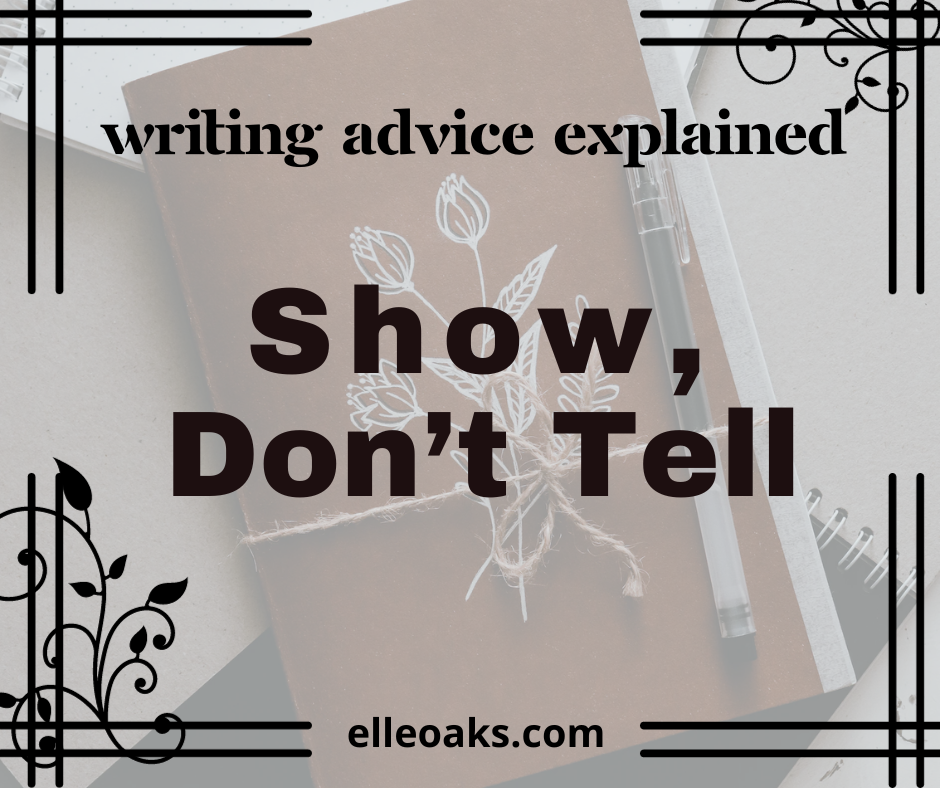If you’re like me, you’ve probably scouted many a forum, article, and writing craft book looking for ways to improve your writing. And if you’re like me, you come across the same advice time and time again. One of the snippets that I always see and hear is the line “Show, don’t tell”. But what does it mean? We’ll dive into this piece of writing advice and explain what it means so you can apply it to your writing and be on your way to improving your skills!

Show Don’t Tell
Let’s start with the basics: definitions. By definition, to tell is to verbally communicate a message to another person, often times explaining what the message means in terms of words. In writing, to tell is to communicate to the reader what is going on in the scene, how the characters are interacting, how they’re feeling. Telling leaves little to the imagination or up for interpretation. It is literal in every sense of the words being presented.
Showing in normal speak is to present something to someone, whether a physical object or through an action. In writing, showing is the antithesis to telling. It is a roundabout way to explore scenes and character relationships and emotions without spelling it all out for the reader. In other words, it’s a craft choice that forces the audience to “read between the lines” so to speak.
But why is showing better than telling?
Maybe it’s not in all situations. There are times when telling can be very effective as it is a very straight forward method of conveying the character’s emotions or what is happening in a scene. For instance, sometimes you won’t want to twirl into a twister of simile and metaphor to describe a character’s fall and the turmoil of their life. Or if you don’t want a line to be open to interpretation, you want the meaning clearly stated for the audience.
However, you cannot take your readers for granted. Most readers don’t want everything handed to them on an elegant platter. Sometimes it’s more entertaining to open up a package and figure out what’s inside.
Showing is a way to immerse the reader in the story. It makes the story less passive and helps to assist in proving the agency of each and every character.
Examples
Rather than saying, “She was angry and went to her room,” we get the sentence, “With furrowed brow and crossed arms, she stomped up the stairs to hide in her room for the rest of the evening.” The first gets the point across as to how the character felt, but that’s really it. The second shows a reaction and uses more powerful words to not only convey the emotion but show it as well.
Another example: “She wore a blue dress with a pearl necklace.” Instead by showing we get “As she walked toward the man, her blue dress swayed with the rhythm of her hips and the pearl necklace shone as dazzling as her smile.” The second helps convey more the sense of character and invites the reader into the scene.
Show don’t tell can also be used for worldbuilding. Exposition and info dumps make one’s writing appear “amateurish”. To truly invite the reader in, you as the writer will need to integrate worldbuilding into a scene in a more natural way. Breaking the pace to drop a paragraph of the setting is doing no one any favors. Here’s an example:
“She ran away from the masked men and through the town. The town was old with brick buildings scattered throughout. A large church stood in the center of town with a tall bell tower and stained-glass windows. An elegant marble fountain sat in the courtyard at the base of the steps to the church. Many people stood huddled about prayer altars in the surrounding gardens. She ran past the groups of people, up the stairs, and into the old church.”
We’re going to evolve this by “showing” now.
“The masked men gave chase. She sprinted down the cobblestone road, eyes scanning side to side in search of an escape or a place to hide. Every brick building she passed showed no promise of helping her, as they could not even help their own deteriorating state due to age. Ahead she noticed the church, its bell tower blocking out the blinding sun as she approached. Rushing past the praying groups of individuals, huddled about altars in the garden, she raced past the marble fountain and straight for the steps. As she pushed open the double doors of the church, the colorful array of filtered light through the stained-glass windows blanketed her.”
As one can see from the examples above, the showing version is more immersive and helps to keep the story on a decent pace rather than breaking up the action to give details of the scene. Integrating tidbits of information throughout a scene rather than in one fell swoop will help to keep the reader intrigued and not pull them from the story.
Sometimes, the “Show, don’t tell” method is as easy as taking a sentence from passive voice to active voice. For more on passive voice and how to avoid it, check out our article by clicking here.
Conclusion
Writing advice can always be tricky and should never be taken at wholesale value. Following the rules will level up your writing, but knowing when to break the rules is just as important when it comes to being a storyteller.
“Show, don’t tell” is a very effective method for immersion and keeping up the pace of the story. It allows for natural introduction of character, worldbuilding, and plot without the clunkiness of info dumps.
Stay tuned as we continue to dissect other pieces of writing advice. Drop your favorite (or least favorite) piece of writing advice below!
Thanks so much for sticking around until the end! If you want to support us in any way, consider buying our books! Click here!


